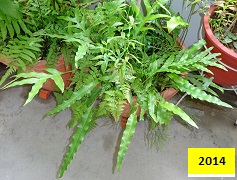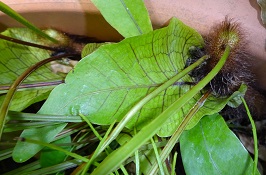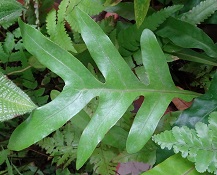| Home | Nature Weekly Index |
16 November 2014 | Oak-leaf Fern (Drynaria quercifolia) |
The pictures below were the same large flower pot over a 4 years period from 2011 to 2014. It was home to a lone Calabur Tree (Muntingia calabura). In 2011, there was a sudden growth of numerous earthstar mushrooms on the soil surface. After the earthstar mushrooms were gone, Rabbit's Foot Fern (Davallia denticulata) started to appear. On top of that, a grass-liked plant started to propagate. I was eager to find out what this unknown plant was. By 2014, the vegetation had effectively shielded the rim of the pot.

.jpg)
.jpg)
.jpg)
The mystery of the grass-liked plant was solved when it started to produce a different type of leaves, one with the shape of fish bone or oak leaf. It was a fern, and the most unlikely fern that I would expect to grow spontaneously from the ground in a pot. However, it does grow on the surface of rock. To make it even more astonishing was the growth of several of them, not just a single fellow.
Oak-leaf Fern (Drynaria quercifolia) starts with slender un-branched fronds when young. As it matures, fronds with broad base will appear along its creeping stem (rhizome). Soon after the broad-base fronds, the third type of fronds with oak leaf appearance started to sprout. This fern is supposed to be nested along tree trunks or large branches on trees. The broad-base fronds act like a bowl collecting dead leaves from the tree while the decaying leaves subsequently provide nutrient to the fern itself.
.jpg)
.jpg)


Due to space constraint, my Oak-leaf Fern was not as robust as those found in the wild. The broad-base fronds were kind of miniature in side though the oak-leaf fronds seemed to be thriving well. The fern was getting along well with the Rabbit's Foot Fern. Although it seemed rather messy with the ferns in the pot, I will continue to keep them as I really like the Oak-leaf Fern. Hope to see them produce spores.
Three other plants lived in the pot as well: (1) another interesting fern, Whisk Fern (Psilotum nudum); (2) a long-term resident, King of Bitters (Andrographis paniculata) and; (3) a common ground cover, Red Flame (Strobilanthes reptans).